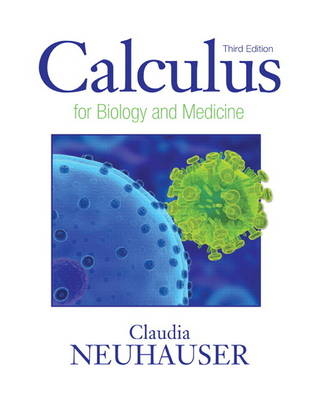
Calculus For Biology and Medicine
Pearson (Verlag)
978-0-321-64468-8 (ISBN)
- Titel erscheint in neuer Auflage
- Artikel merken
Claudia Neuhauser is Vice Chancellor for Academic Affairs and Director of the Center for Learning Innovation at the University of Minnesota Rochester (UMR). She is a Distinguished McKnight University Professor, Howard Hughes Medical Institute Professor, and Morse-Alumni Distinguished Teaching Professor. She received her diploma in Mathematics from the Universität Heidelberg (Germany), and a PhD in Mathematics from Cornell University. Before joining UMR in July 2008, she was Professor and Head in the Department of Ecology, Evolution and Behavior at the University of Minnesota—Twin Cities, and a faculty member in mathematics departments at the University of Southern California, University of Wisconsin—Madison, University of Minnesota, and University of California—Davis. Dr. Neuhauser’s research is at the interface of ecology and evolution. She investigates effects of spatial structure on community dynamics, in particular, the effect of competition on the spatial structure of competitors and the effect of symbionts on the spatial distribution of their hosts. In addition, her research in population genetics has resulted in the development of statistical tools for random samples of genes. In her role as Director of the Center for Learning Innovation at the University of Minnesota Rochester, Dr. Neuhauser is responsible for the development of the Bachelor of Science in Health Sciences. The Center promotes a learner-centered, concept-based learning environment in which ongoing assessment guides and monitors student learning and is the basis for data-driven research on learning. Dr. Neuhauser’s interest in furthering the quantitative training of biology undergraduate students has resulted in a textbook on Calculus for Biology and Medicine and a web page Numb3r5 Count! (http://bioquest.org/numberscount/). In her spare time, she enjoys riding her bike, working out in the gym, and reading history and philosophy.
1. Preview and Review
1.1 Preliminaries
1.2 Elementary Functions
1.3 Graphing
2. Discrete Time Models, Sequences, and Difference Equations
2.1 Exponential Growth and Decay
2.2 Sequences
2.3 More Population Models
3. Limits and Continuity
3.1 Limits
3.2 Continuity
3.3 Limits at Infinity
3.4 The Sandwich Theorem and Some Trigonometric Limits
3.5 Properties of Continuous Functions
3.6 A Formal Definition of Limits (Optional)
4. Differentiation
4.1 Formal Definition of the Derivative
4.2 The Power Rule, the Basic Rules of Differentiation, and the Derivatives of Polynomials
4.3 The Product and Quotient Rules, and the Derivatives of Rational and Power Functions
4.4 The Chain Rule and Higher Derivatives
4.5 Derivatives of Trigonometric Functions
4.6 Derivatives of Exponential Functions
4.7 Derivatives of Inverse Functions, Logarithmic Functions, and the Inverse Tangent Function
4.8 Linear Approximation and Error Propagation
5. Applications of Differentiation
5.1 Extrema and the Mean-Value Theorem
5.2 Monotonicity and Concavity
5.3 Extrema, Inflection Points, and Graphing
5.4 Optimization
5.5 L’Hôpital’s Rule
5.6 Difference Equations: Stability (Optional)
5.7 Numerical Methods: The Newton-Raphson Method (Optional)
5.8 Antiderivatives
6. Integration
6.1 The Definite Integral
6.2 The Fundamental Theorem of Calculus
6.3 Applications of Integration
7. Integration Techniques and Computational Methods
7.1 The Substitution Rule
7.2 Integration by Parts and Practicing Integration
7.3 Rational Functions and Partial Fractions
7.4 Improper Integrals
7.5 Numerical Integration
7.6 The Taylor Approximation
7.7 Tables of Integrals (Optional)
8. Differential Equations
8.1 Solving Differential Equations
8.2 Equilibria and Their Stability
8.3 Systems of Autonomous Equations (Optional)
9. Linear Algebra and Analytic Geometry
9.1 Linear Systems
9.2 Matrices
9.3 Linear Maps, Eigenvectors, and Eigenvalues
9.4 Analytic Geometry
10. Multivariable Calculus
10.1 Functions of Two or More Independent Variables
10.2 Limits and Continuity
10.3 Partial Derivatives
10.4 Tangent Planes, Differentiability, and Linearization
10.5 More about Derivatives (Optional)
10.6 Applications (Optional)
10.7 Systems of Difference Equations (Optional)
11. Systems of Differential Equations
11.1 Linear Systems: Theory
11.2 Linear Systems: Applications
11.3 Nonlinear Autonomous Systems: Theory
11.4 Nonlinear Systems: Applications
12. Probability and Statistics
12.1 Counting
12.2 What is Probability?
12.3 Conditional Probability and Independence
12.4 Discrete Random Variables and Discrete Distributions
12.5 Continuous Distributions
12.6 Limit Theorems
12.7 Statistical Tools
| Erscheint lt. Verlag | 14.1.2010 |
|---|---|
| Sprache | englisch |
| Maße | 220 x 283 mm |
| Gewicht | 1730 g |
| Themenwelt | Mathematik / Informatik ► Mathematik ► Analysis |
| ISBN-10 | 0-321-64468-9 / 0321644689 |
| ISBN-13 | 978-0-321-64468-8 / 9780321644688 |
| Zustand | Neuware |
| Haben Sie eine Frage zum Produkt? |
aus dem Bereich



